|
Wave Of Banditry Sweeps Ledo Road
Roundup Staff Writer MYITKYINA, BURMA - Four months after V-J Day, the peaceful green valleys of North Burma once again echo to the noise of rifles, tommy-gun and mortar fire. Burmese and Kachin villagers, trying to rebuild the ruins of their war-torn homes, and the last few hundred GI's left behind to guard and dispose of surplus property have been caught in a wave of banditry organized by deserters and renegades from the armies that once swept through Burma. The bandits are well armed with tommy-guns and other automatic weapons. Their aim seems to be the capture of goods for the still-flourishing black market, and the securing of food, clothing and arms to maintain themselves. The principal difficulty in dealing with the situation is that the armed bandits, wearing their old uniforms by night, become "peaceful" civilians during daylight hours. To date no American personnel have been injured, but one British Civil Affairs police sergeant has been killed and several other police wounded. Since V-J Day, 10 bandits have been killed by American employed guards (Gurkhas and Kachins). An equal number have been captured and turned over to the British authorities for punishment. The British civil administration has killed 25 bandits. Small stores of arms and ammunition have also been taken. DESCRIBE ‘SCHOOL’ Reliable American officers described a "school" hidden in the jungle near Namti, which they believe may be one of the organizational centers of bandit activity. They found a large meeting in progress in the jungle clearing. The man in charge said it was a school, but none of the students appeared to be under 25 years of age. Arms, ammunition, and black market goods are known to be located at the "school," and the Namti area is one of the hottest spots in North Burma. The most recent episode took place on Saturday night, December 17, just two days before I arrived in Myitkyina, in the area formerly occupied by the 48th Evacuation Hospital. Here large quantities of surplus Quartermaster property are stored. Kachin and Gurkha guards were roused in the late evening by a "psychological attack" out of the jungle. The bandits howled, beat tins cans and in general gave a good imitation of a Banzai charge. FOUR ARE SLAIN A group of four bandits stepped out of the jungle. The guards saw them enter the warehouse, and start to walk out with American equipment. The guards shot, killing all four. On this same day, Dec. 17, three enlisted men from the 3845th QM Truck Company were fired at with a tommy-gun from an ambush in the jungle while driving the road. Most severe encounter to date involving American property took place on Nov. 23 at 10:00 hours at pumping station Post 2 along the pipeline. The small group of guards was set upon by 25 bandits armed with shotguns, pistols, carbines and tommy-guns. The outnumbered guards had to withdraw into the jungle, while the bandits demolished their living quarters with hand grenades. Although several hundred rounds were fired, no casualties occurred. On the night of Nov. 22, bandits attacked a village on the east bank of the Irrawaddy in the Myitkyina area. In a pitched battle during which British fired about 5,000 rounds, the Civil Affairs Sergeant was killed. During the first week of December, S/Sgt. Roy Swatzel, Sgt. Elton Eady and Sgt. Lyle Stotts, of the 330th Engineers, were almost caught in an ambush attack on the road between Bhamo and Myitkyina. TWO NEARLY SHOT On Nov. 20, T/Sgt. George Hittney and Sgt. Gerald Giest of the 1756th Engineer Petroleum Distribution Co., were driving along the road distributing rations to guards at pipeline pump stations. Forty miles south of Myitkyina they were flagged down by someone on the road with a flashlight. They saw the man was not a GI, so they sped ahead. Bandits emptied a full tommy-gun clip at their rear tires from a jungle hideout. S/Sgt. Martin Reitzel, from the same pipeline outfit, stopped in broad daylight in the same area to fix a tire on Nov. 17. Two bandits approached asking for cigarettes. When they got close, they whipped out .45 automatics, robbed Reitzel and his GI companion of all their personal belongings, and drove off with the jeep. The GI's were shortly picked up by two ATC men. Together, they followed the tracks of the stolen jeep into a jungle clearing where they came upon the vehicle. As they drove the recovered jeep out of the brush, they were fired on. Slugs pierced the windshield and rear of the vehicle. The driver of a weapons carrier of the 3101st Signal Battalion was robbed at the point of a gun on Nov. 20 by two civilians to whom the driver had given a ride. The vehicle was later found in a bazaar at Myitkyina. Other evidence of banditry have appeared in the Warazup area recently and, previously, near Bhamo. |

Vol. IV No. 17 Delhi, Thursday, Jan. 3, 1946 Reg. No. L5015
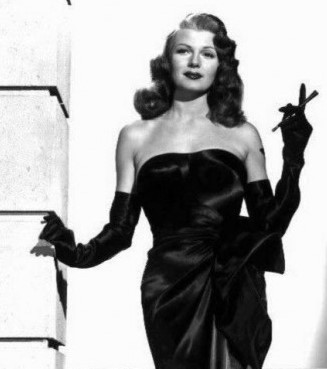 Here's Rita Hayworth, all covered with silk and glamor, who says she wants a separation from hubby Orson Welles, screen and radio star,
and film director. Only a month after their marriage, she pouted, he wanted to "saw her in half" during an act in a tent show.
(Acme Photo)
Here's Rita Hayworth, all covered with silk and glamor, who says she wants a separation from hubby Orson Welles, screen and radio star,
and film director. Only a month after their marriage, she pouted, he wanted to "saw her in half" during an act in a tent show.
(Acme Photo)
|
NEW DELHI - Limited quantities of new portable typewriters, parachute silk, bantam Kodaks, mountain troop knives and Coleman portable stoves have been purchased from the Foreign Liquidation Commission for sale at cost price in Army Post Exchanges throughout the I-B Theater. Drafting instruments and other engineering material may be included.
The announcement came from Maj. B.E. Ryan, Theater Post Exchange Officer, who emphasized that due to the limited amount of such items available a "turnabout" system of distribution has been established whereby a PX may get one item and not the next.
As an example of small lots available, Maj. Ryan cited the total of 75 cameras which will go on sale. He said that is all the PX's were able to get.
‘FIRST CRACK’
"We are dividing everything as equitably as possible," declared Maj. Ryan. "The FLC has given us first crack at everything, and anything offered to us at all which we thought the boys wanted and that we could sell, we've been grabbing up.
"The Post Exchanges are now out of debt and we are selling the items at the FLC price, without profit."
These prices compare very favorably with United States peacetime prices, he pointed out. "Our Corona portable typewriters are being placed on sale at Rs. 150. The Stateside pre-war price was $44.50 (approximately 148 rupees) and now, I understand, they are retailing at around $54."
SILK SOLD
The parachute silk - there was a transaction for 8,000 yards from the FLC to the Exchange Service - is being sold across counters at Rs. 1-6 (approximately 42 cents) a yard. Before the war the same material reportedly was retailing in the United States for 90 cents a yard.
Also tabbed as considerably below Stateside prices are Coleman stoves, expected to go at something like Rs. 22-12, and mountain troop knives at less than six rupees.
Up to this week, FLC items had been sold in Calcutta area PX's. The major said a small variety of articles will now be placed on sale in PX's in Ledo, Chabua and New Delhi.
ADDED U.S. TROOPS
TO SEE CHINA DUTY
SHANGHAI - (ANS) - Lt. Gen. Albert C. Wedemeyer said early this week that the United States would help to pour Chinese National troops into Manchuria and would have to increase American forces in China by possibly 4,000 men.
The commander of U.S. forces in China did not specify whether ships or planes would be used, telling a press conference that details were "still under consideration."
|
Wedemeyer declared however that American troops would go along with the Central Government forces to supervise demarkation, handle supplies and give other aid in line with America's broadened China policy.
This meant, Wedemeyer continued, that Army personnel would have to be built up to 12,000 to 15,000 men, even though it would require bringing in 3,000 to 4,000 more troops from the States or elsewhere.
These troops would be in addition to an estimated 50,000 Marines now guarding a number of port cities and railways in North China along the route to Manchuria.
Meanwhile the Army newspaper Stars and Stripes said in a dispatch from Tientsin that the morale of American marines in North China is "lousy." The paper said that battle-weary men "who have had too much fighting, want to go home and nothing else seems to matter." The paper cited instances of brawls and an increasing rate of mental illnesses as evidence.
ATC Moved 61,000 Men Homeward To Karachi
By SGT. CARL RITTER Roundup Staff Writer
If it hadn't been for the Air Transport Command, some Joes who found themselves in September to hellangone across India from the Karachi port of embarkation would have had a much rougher time of it.
That is a fair-sized understatement. The truth is, a sizeable chunk out of 61,000 - a figure representing the number of troops moved across India by air in September, October, November and December - still might be twiddling their mess gear somewhere in the hinterlands.
Others would be bemoaning the six-day or seven-day train ride in crowded cars which would have shunted them to the POE. The planes crossed India an half a day.
As it was, 37 trains conveyed 18,550 trans-India troops during the period from Sept. 10 to Nov. 29, when the last Karachi-bound train left Assam.
Army Air Force planes, normal media for carrying heavy troop traffic by air, had been transferred to smoldering China. The I-B Command, anxious that vets be transported to Karachi "Jaldi" and comfortably as possible while filling promptly such shipping as the 50,000 allocations for October, looked to the ATC.
The ATC came through, even though it might have been looking toward the end of big movements here after flying the Hump since the start of air operations in the theater.
Flying C-54's almost exclusively, the ATC counteracted the loss of AAF troop carrier units to China by flying 14,000 troops across India in September, 20,000 in October, 20,000 in November and 6,700 in December.
The figures do not include troops air lifted from New Delhi, Agra or other part-way locations.
SAVED FIVE DAYS
Troops crossed India from VLR (Very Long Range) fields in West Bengal and the Calcutta area to ease the load on Camp Kanchrapara, to avoid congestion at Calcutta and to save time. Karachi's ships to the United States east coast saved five to six days one way and twice that on the complete turn-around between India and the United States.
Sixteen vessels left Karachi for the east coast of the United States from September through November. Figuring 12 days saved per round trip, the use of Karachi as a full operational port of evacuation - thanks to the help of the ATC - gave 192 extra days or more than the time necessary for four ships to make round trips.
45,000 MOVED
In addition to the trans-India troop movement of the past four months was the air evacuation of approximately 45,000 troops from Kunming in west China and Lucknow in the central region. These troops, with exception of 2,400 Chabua-bound, were sent to VLR fields and to Kanchrapara.
In covering more than 70,000,000 man-miles in the trans-India operation alone, the ATC lost one plane, a C-54 which crashed in ____ ing men here from China.
Violent Storms In Atlantic Ocean Batter Navy Ships Mail Delivery To I-B Troops Moves Ahead
|
Roundup Staff Article
The violent hurricane and wind storms, centering in mid-Atlantic, continued last week to cause delays in the return of American troops to East Coast ports, although the extreme cold wave, which settled over the northeast United States shortly before Christmas, appeared to have moderated.
Mail deliveries, to and from this Theater which were halted for approximately seven days over the Christmas holiday by the Atlantic storm, were resumed however, the first air mail arriving in the Theater last Thursday, postal authorities announced.
The Theater Postal Officer added that some first class parcel post, flown from India to Casablanca, then held because of the storm, was put aboard boats from the North African port to clear the backlog there. No letter mail was handled this way however.
The cruiser, USS Portland, arrived in New York last Friday with troops and sailors telling of terrific gales on the Atlantic which took a toll of two soldiers dead, one missing and 22 injured, Army News Service reported.
The Portland's Capt, Lower Bibby described the weather as "the worst storms I have been in during 28 years of naval seafaring."
Echoing the Portland's captain was the skipper of the light cruiser USS Boise, Capt. Charles Hartman, who said it was "certainly the worst crossing I ever made."
The Boise, originally due to arrive by Christmas, docked three days late with 1,189 servicemen, although no casualties from the storms were reported aboard it.
|
Several injuries were suffered by 30 American troops travelling homeward aboard the French liner Athos. The ship, loaded with 3,000 GI's, was moving toward New York when she was hit by the hurricane. Last reports indicated she was heading for the Azores at reduced speed due to engine trouble.
In New York, the light cruiser USS Philadelphia, her forecastle deck buckled, her hull plating ripped and her gun shields and fittings twisted by wind limped in last Tuesday with 1,266 military personnel aboard, whose disappointment in not getting home by Christmas was overshadowed by joy in reaching land.
"We did everything possible to get the boys home for Christmas and still preserve the ship," Capt. Robert W. Berry, the ship's skipper declared. A roll of 41 degrees delayed the vessel, he added.
A storm in the San Francisco area prevented the Coast Guard from carrying out its scheduled "Santa Claus" mission to tiny, isolated Farrelon Island, 25 miles west of the Golden Gate, where the inhabitants have been marooned for more than a week because of heavy seas.
A Consolidated Catalina, manned by airmen of the South San Francisco Coast Guard Air Station volunteered to double for Santa and flew into the heavy storm near the island, but was unable to parachute Christmas presents, mail and essentials for Christmas dinner which they sought to deliver.
The cold wave which had struck the northeast corner of the nation abated somewhat after Christmas. Extreme cold had moderated over most of the country by last Monday, but sleet and freezing rain made holiday travel treacherous for Midwest and Eastern motorists.
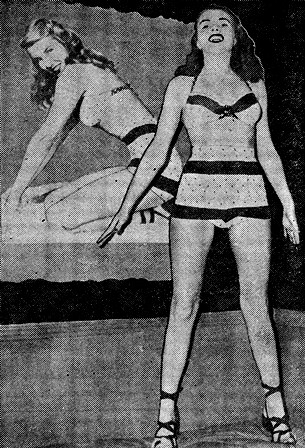 The life-size pin-up photo that a group of GI's voted as being the "Picture of the Year" comes to life in New York and we see pert
Patricia Vaniver, a Walter Thornton model, smile for the birdie. GI's would like to see this magic worked in India and Burma.
(Acme Photo)
The life-size pin-up photo that a group of GI's voted as being the "Picture of the Year" comes to life in New York and we see pert
Patricia Vaniver, a Walter Thornton model, smile for the birdie. GI's would like to see this magic worked in India and Burma.
(Acme Photo)
|
Small Security Units Hold
Last U.S. Outposts in Burma
By CPL. ED ALEXANDER Roundup Staff Writer
MYITKYINA, BURMA - The second march out of Burma is almost completed. This time, instead of a bedraggled, beaten army walking out on foot, it is a proud, victorious Army that has flown out and driven back to Ledo over the Stilwell Road.
But still left behind to guard and dispose of the last items of surplus property are a few hundred GI's in Shingbwiyang, Tingkawk, Warazup, Bhamo and Myitkyina, with the great bulk in Myitkyina.
The last group of men of Burma will probably be the Security detachments at Myitkyina and Bhamo. While the Security detachment at Myitkyina awaits orders to pull out, it lives a pleasant life of GI luxury behind an electrically-charged barbed wire fence patrolled by armed Gurkhas and Kachin guards.
In what were formerly Officer's Quarters, this small group of 53 men, on DS from the 330th Engineers, enjoy meals served by bearers on white tablecloths; live in the privacy of two-man rooms with simulated fluorescent lighting fixtures; take hot showers, view movies from the depths of cushioned arm-chairs; and best of all, revel in the bracing chickenless air of Burma.
For Thanksgiving dinner, wine, specially purchased in Calcutta at the personal expense of their CO, Capt. William W. Nelson, was served along with the stateside turkey!
Most fascinating feature of North Burma now is the "private army" of about 900 Kachins and Gurkhas - the American Ranger Guards - organized under the Security detachment to guard installations from Myitkyina to Wanting. The valiant tradition of the OSS American-Kachin Rangers, and the Gurkha who voluntarily joined the U.S. forces at the north airstrip during the siege of Myitkyina, is being carried on till the very end by these Ranger Guards.
The Rangers are a queerly mixed army. Their uniforms are mainly salvaged American stocks, with a sprinkling of British clothes. Their system of rank follows the Indian Army. But in their orderly room, they make out Morning Reports, Ration Requests, Sick Book, Duty Rosters - and even Honorable Discharges in strictly GI style.
|
The Kachins and Gurkhas have a complete hospital of their own, under the supervision of Miss Kwang Twsi, lovely Kachin nurse who is a "graduate" of Dr. (Burma Surgeon) Seagrave's hospital at Namkham.
The well-stocked Ranger arsenal is a mixture of Japanese knee-mortars, machine guns, M-1's, tommy-guns, British Sten guns - just about any weapon that could be picked up or salvaged from the Burma battlefields.
The Guards were organized in October of 1944 to relieve GI's of arduous and dangerous guard duty, by Col. L. L. Lamarche. Originally they consisted of Gurkhas, recruited principally by Subedar Major R.K. Pradham. The Subedar Major was caught in Myitkyina by the Japanese occupation and forced to give Jap troops physical training. When Merrill's Marauders captured the north strip, Pradham escaped from Myitkyina Town and joined the U.S. forces.
In May of this year, Ranger ranks were thrown open to the Kachins. Subedar Major Ma Ran La, the peace-time schoolmaster of Myitkyina Town, who fought with the OSS Kachin-American Rangers, was largely responsible for the recruitment of the present large force of Kachins.
With eight GI's as sergeants of the guard, the Ranger Guards maintain 150 posts in the Myitkyina area, plus outposts along the pipeline all the way to Wanting in China. They also maintain a mounted horse patrol of 30 men.
Right now, the Rangers, who cut four bandits to ribbons with tommy-gun fire only a few nights ago, are busily preparing a party for their GI buddies at Myitkyina's abandoned Red Cross building.
Besides the Security detachment, there are left in Myitkyina detachment of the 3101 Signal Battalion, the 354 Medical Dispensary, 898 Ordnance, Co. B of the 330 Engineers, 624 M.P. Co., 3845 QM Truck Co., 1756 EPD Co. and a small headquarters detachment of the Myitkyina sub-depot.
|
GI’s Join Doc Seagrave’s Nurses
In Burma Christmas Festivities
(Second of a series in which the Roundup makes a final tour of north and central Burma battlegrounds).
By CPL. ED ALEXANDER Roundup Staff Writer
NAMKHAM, BURMA - Christmas Day 1945, at Doc Seagrave's old hospital here dawned with the nip of winter in the air. Fog hung heavy over the Schwelhi valley. The trees outlined a home-like tracery against the mist. The stone buildings of the hospital, festooned with wreathes and red paper, loomed out of the fog, for all the world like the New England countryside.
But when the sun broke through in late morning, Christmas Day at Namkham changed its dress. Now you could see the rice paddies, the banana palms and the people of the valley and surrounding hills plodding past.
There were Kachins, with their hair cut square all around; red skirts and leggings; silver ornaments against black jackets; and lacquered bamboo rings encircling their waists. There were ancient Shan women, toiling up the hill with babies strapped on their backs; hair piled high on their heads, swathed in black; grinning vacantly through teeth blackened and decayed by betelnut. There were Burmese, Karens, Palongs, Chinese.
SEASON'S SPIRIT
The sun illumined the whole exotic panorama of that far-off never-never land - the Shan States.
Of all the distant, queer places in which GI's spent the Christmas of 1945, Namkham was the most distant, the most queer. Yet of all the Americans still overseas the five who spent it at Namkham - Lts. Francis A. Duffy and Lee F. Dougan, S/Sgt. Merl Fogel, T/5 Wesley J. Theobald and myself - felt closer to the spirit of Christmas at home than any.
For, through the work of Doc Seagrave, "the Burma Surgeon," and his famous nurses, the essential, world-wide spirit of the season had been brought to life for us on the hillside overlooking the rice paddies.
Last year the Shan, Kachin, Karen and Burmese Christians celebrated Christmas from hideouts in the hills. Last year, the son of the pastor himself was beheaded with a dull sword.
Not finding Dr. Seagrave at Namkham, the Japs took blind vengeance by hanging his pet dogs to the rafters, slitting their bellies and leaving them to die. The commanding general of the Japanese Fourth Army lived in the very bungalow where we slept.
Dr. Seagrave was Lt. Col. Seagrave then, chief medical officer of U.S. forces in Burma. Last Christmas he and the girls were fighting their way back to Namkham with the Men of Mars - as the Seagrave Unit of the U.S. Army. Now the gang rarely gets together. Doc is busy elsewhere as chief surgeon of the Shan States. The old time nurses are scattered through Burma, running hospitals and dispensaries on their own.
So this first peacetime Christmas was a rare reunion - Doc, the girls, Maj. Bha Saw, Namkham's present chief surgeon, and Dr. Grace, Seagrave's sister, were all there.
THREE-DAY FEAST
Above all, the people of the valley were there. The few hundred church members had raised 3,000 rupees for a three-day feast and festival. Four thousand villagers - Christians and Buddhists alike - came to celebrate Christmas with "The Burma Surgeon."
All of what Doc Seagrave - the scientist-missionary - means to the people of the Shan States, seems embodied in the nurses. Here are a group of nurses to compare with the products of America's best hospitals. Beside nursing, they perform minor surgeries, instrument deliveries, abdominal punctures.
They have been through the grimmest fighting of the war. They walked out of Burma with General Stilwell in 1942 and walked back with him in victory. They won a Presidential unit citation.
|
Yet they manage to be among the most vivacious, charming, well-groomed girls on earth. Little Bauk spent her whole month's salary plus 15 rupees on a new silk longyi for the Christmas party. Little Sister always has fresh flowers in her hair. You have to go to Namkham to appreciate the unbelievable combination of infectious, fun-loving camaraderie with innate modesty and simplicity that marks the Seagrave nurses.
Doc Seagrave's girls sing and laugh every minute of the day that is not occupied by grim work in the surgery. When we arrived at Namkham at 10 p.m. they were singing. Christmas Eve, we sang together in front of a blazing hearth-fire till midnight - carols, Burmese folk songs, the latest cowboy songs, spirituals.
At 2 a.m. and 4 a.m. Christmas morning the girls sang carols under our bungalow window. On Christmas night - after the four-hour church program and the six-hour service - we sang around the fireplace again. Yet just a few years ago, before the hospital and school were built, they were among the little girls from the hills and paddies who walk endlessly along the roads of Burma carrying heavy baskets of rice.
But Doc Seagrave believed in the spirit of Christmas - the brotherhood of man, the innate decency and strength of the common person, regardless of race or nationality.
He gave nothing material to these girls. He simply gave them a chance to develop what was in themselves. He laid before them the riches of science and culture. Even now, the families of many of these same girls live a near-primitive existence in villages 15 miles back in the wild hills, yet within one generation, a small group has arisen who are the historic prototypes of a new, finer, freer way of life for the peoples of Burma.
The Americans who fought in Burma are gone. "The Burma Surgeon," Klah Sen, Little Bauk, Julia Tee and all the Seagrave gang will stay behind.
So farewell from the GI's of the IBT to Doc and his girls - those rare people who are putting into operation after the war the ideals for which they fought.
On Christmas Day of 1945, five U.S. soldiers saw the brotherhood of man on a hillside overlooking the green Schwelhi valley - and it works.
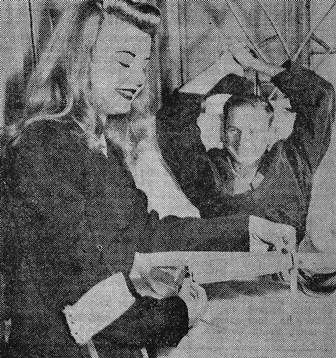 Pretty Noreen Johnson, 17, a polio victim since 1942, pins a nameplate on the bed of Pfc. Roy H. Bullard of Detroit, in a Chicago hospital.
The bed is one given to the hospital by the Spauling School for Crippled Children, which she attends.
(Acme Photo)
Pretty Noreen Johnson, 17, a polio victim since 1942, pins a nameplate on the bed of Pfc. Roy H. Bullard of Detroit, in a Chicago hospital.
The bed is one given to the hospital by the Spauling School for Crippled Children, which she attends.
(Acme Photo)
|
California Woman Awaits Chance
To Return To Her Home At Rangoon
By SGT. MICHAEL J. VALENTI Roundup Staff Writer
To white-haired, bright-eyed Mrs. Sue Upfill, of the OWI's New Delhi branch, "Shangri La" is not her old home town of Willows, Calif. - It's Rangoon, Burma.
Burma's first city is home to the American woman who lived through the hell of the Japanese blitz there on Christmas Day four years ago, who lost her husband during the evacuation and who, in spite of the death and disease she has seen in the Orient, wouldn't live anywhere else.
The old Burma Road, with which the Allies forged the Stilwell link in their blood, sweat and toil, is as familiar and homey to Mrs. Upfill as Main Street, U.S.A. is to India-Burma GI's. In her 15 years in the country that to other of her countrymen was a "green hell," Sue Upfill got to know every ramification, every bend, every turn of that road.
TO GO TO U.S.
Next month she will go Stateside for a rest. But, like the British soldier says in the Kipling poem, "There's a Burma gal awaitin'" although she's not "a-smokin' of a white cheroot." And that's one reason she's coming back - to see to the education of Makyimyint, the Burmese girl whom she brought up from the age of six, and to see that she becomes a solid citizen of Burma.
Mrs. Upfill found Makyimyint - which means "bright star" - in a hospital in Rangoon back in 1932. The Willows, Calif. girl with a law degree had come to Burma from Honolulu to amalgamate and coordinate the activities of certain law firms. There she met and married the British manager of the New Zealand Insurance Company. They settled down. Then she became bored with life, she said, so she took up social service and became president of the National Council of Women.
In her ministrations of relief to the poor, she met little Makyimyint. The six-year-old child was tubercular and weighed 28 pounds. Mrs. Upfill put her in a hospital, and when it was time to leave, "Bright Star" wanted to go home with "Mamaji" Upfill. Mamaji couldn't resist the tot and virtually adopted her. "Bright Star's" parents were dead, so she began to rear the child as her own.
Life was happy for Mrs. Upfill. "In the East," she said, "there is a gracious way of living. Nowhere else can you live so pleasantly on the same amount of money. The West has its labor-saving devices, but the East has its servants. There's too much rush and bustle in the West."
She had her collection or orchids, 5,000 of them, probably the largest at that time in Burma. She travelled up and down Burma, she shot 10,000 feet of film recording Burmese customs, dances, folk-lore and festivals - 6,000 feet in color - she knew the thrill of being the first white woman to climb Mt. Kyaik Toyo with the teetering rock, had seen the strange snake worshippers of Mt. Popa who allowed giant cobras to kiss them in the mouth with their fangs, and had set eyes on a thousand and one sights that no white woman had ever seen before.
Then, in 1941, the Japs struck - Mrs. Upfill's world tumbled down around her shoulders. Five bombs crashed into her house, reducing it to ruins. Rangoon was in flames. As a worker in St. Philomena's Hospital, she helped take in women and children who had been strafed on the Maidan. She herself suffered a shrapnel hit in her foot.
|
When the chief of police of Rangoon needed some Europeans to stay behind to supervise the demolition of the port, Mrs. Upfill's husband and two brothers volunteered. The mission was accomplished, and the last-ditchers got away safely in a boat. Mrs. Upfill had left on the last American boat out of Rangoon. Bright Star had left days earlier. She was to meet her husband in Calcutta.
BITTER FATE
When his vessel came into the Hooghly, fate provided an ironic, bitter twist. For, after the hazards he had just passed through, Upfill was strolling the deck late one night, when somehow he fell overboard into the swift-running tide and was drowned.
Mrs. Upfill reached New Delhi via Calcutta where she immersed herself in work for the OWI. Before Special Services took over, she served on the Red Cross committee which at the time was providing the only recreational facilities for servicemen here.
Now that the war is over, Mrs. Upfill looks forward to a visit back to Willows, where her brother runs a tri-weekly newspaper. She says she's going to do a little writing about her experiences. But she knows she'll soon feel the call of Burma, and she'll have to answer, because that's where home is.
USAFI Lists New Policy
As many as nine months will be allowed after date of discharge for soldiers to complete United States Armed Forces Institute courses, under a new policy announced by Lt. Col. E.F. Gerold, Jr., commandant of the CBI Branch of USAFI.
Indications were that many GI's had decided against taking USAFI correspondence courses in recent months because they did not expect to be able to complete courses while in military training.
"This extension is a decided advantage to students," explained Col. Gerold, "because previously an enrollee could not submit course lessons after discharge, although he could continue the lessons on his own.
"Now a student may continue to send in lessons right along up to nine months, if necessary, after his discharge," he explained. If the student wishes, he can take an examination after finishing the course.
USAFI courses are available in a wide variety of fields including engineering, science, foreign languages, radio, psychology, railways, business, music and art, drafting, photography and merchandising.
|
OUR RAY FORSAKES HIS SPORTS TO WELCOME VETERAN USO TROUPE 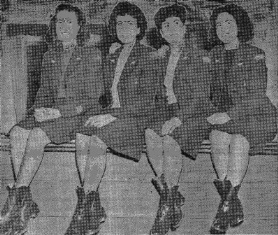 These fair damsels are part and parcel of the USO troupe "Maids and Magic," now touring the Theater.
Left to right: Margery Edwards, violinist from San Jose, Calif.; Singer Annabelle Escoe, Oklahoma City; Las Tosca, Spanish dancer from
San Francisco, and Lila Escoe, pianist and sister of Annabelle.
The show, now doing the Karachi area, will move to Base Section, Jan. 21.
(Signal Corps Photo)
These fair damsels are part and parcel of the USO troupe "Maids and Magic," now touring the Theater.
Left to right: Margery Edwards, violinist from San Jose, Calif.; Singer Annabelle Escoe, Oklahoma City; Las Tosca, Spanish dancer from
San Francisco, and Lila Escoe, pianist and sister of Annabelle.
The show, now doing the Karachi area, will move to Base Section, Jan. 21.
(Signal Corps Photo)
Flaunting a neat one-two punch in comedy and musical technique, the USO-Camp troupe "Maids and Magic" last week began a scheduled tree and a half months tour of the India-Burma arena. Four comely girls, plus an older couple and a male magician, have pooled their talents to offer one of the more sprightly USO shows to hit the theater in some while. What's more, all are veterans at this overseas barnstorming and pack more Hershey bars than the entire Pearl Harbor All-Stars football team. Take Margery Edwards, for example. She has three gold stripes and more travel time than the late Richard Halliburton. OVERSEAS STRIPES Margery, a most talented violinist, first hit the cold regions, including Labrador, Newfoundland, Alaska and the Aleutians. Then in company with the other girls, she went to the Caribbean Defense Command, the Canal Zone and the Middle East before coming here. The troupe plans a China Theater trek, if possible, and will also play Italy before heading Stateside next summer. Incidentally, for those who prefer a hometown touch, Margery is one of three Californians in the show. She is a native of San Jose, though presently resides in New York City. Bob Damon, the legerdemain man, is a Los Angelino by way of South Dakota, and La Tosca (nee Tosca Lippi) hails from San Francisco. HIP SHAKER La Tosca, a dancing instructor in civvies, does some Spanish numbers for the boys in service. She shakes her hips better than Army's Glenn Davis in an open field. A more pleasant performance, too. Two sisters, Lila and Annabelle Escoe, are the contributions from Oklahoma City. Lila is the accompanist at the piano, and the poor man's Cass Daley in her spare time, while Annabelle puts out with vocals. Annabelle is also adept at the violin and piano, but prefers to exercise her tonsils. Al Verdi, a chubby-citizen who slaps a solo cello, got the main attention from the New Delhi commandos when the show was previewed recently. Dolores Verdi is the mistress of ceremonies and the couple proved that their outstanding stage background is no mistake. They've done stints with countless name bands. Magician Damon is better than the ordinary with his sleight-of-hand and various illusions. He did everything but pull my discharge papers out of his pocket. The itinerary calls for the show to be around the Karachi area until Jan. 21, then it moves to Base Section. They'll close out by playing the Intermediate Section installations. Another collection, "Arabella's Show Shop," also has arrived in I-BT. More of them anon. I'm getting to like this amusement business. E. Gartly Jaco can keep his movie reviews. |
Spray Fliers Near
Finish Of I-B Task
HQ., ARMY AIR FORCES - Ending it's unique career in the India-Burma Theater soon is the I-B Malaria Spraying Flight more popularly known as the "Skeeter Beaters."
Only a small group of the I-B DDT bombardiers remain to cover the areas where American personnel will be concentrated until the final closing date of the Theater.
The first ordained aerial executioners of "Annie," the anopheles mosquito, made their entrance into India-Burma in late 1944, under the command of Capt. William D. Hartman, veteran combat pilot of the 12th Bombardment Group, the "Earthquakers."
The ground work for this organization was completed in October 1944, by Captain J. W. Wilson, India-Burma Theater Malarioligist, after months of research and tests of the spray using various types of aircraft.
The nucleus of this outfit came from the 173rd and 174th Malaria Control Units and it gathered strength as operations spread out to include freshly liberated portions of Burma. Operating out of Upper Assam, stripped-down Mitchells covered the greater part of India and Burma with several DDT refueling points for distant areas.
One of the favorite stories emanating from the "Skeeter Beaters" happened on a spraying mission over a fighter strip at Sahmaw, Burma. On the first approach, the B-25 caught the wind-sock off the operations tower, forcing the Mitchell to land.
When the hatch of the aircraft opened, out came a parade of occupants that must have been torn straight from the album of Bill Mauldin's characters. The tall, heavily-bearded radio operator strode leisurely over to the operations office and you can imagine the consternation that came to an already enraged operations officer when this animated "Sad Sack" greeted him with, "Sorry 'bout da sock Cap. How's da bugs in dis hole?"
That's the way the "Skeeter Beaters" operated. In a strictly informal way, they eliminated 90 percent of "Annie's" cohorts using 12,000 gallons of DDT to accomplish that mark.
The "Skeeter Beaters" had their taste of combat while spraying front line areas where the anopheles mosquito made haste in attacking unsuspecting and busy GIs. In diving over the men, the Mitchells had to pull up sharply to avoid enemy ground fire.
With the inactivation of the "Skeeter Beaters," the GIs and Medical Corps are more than satisfied that time and effort expended by the Malaria Spraying Flight was well worth the while, because, "Annie doesn't live here anymore."
I-B SERGEANT FINDS POLISH RELATIVES
KARACHI - He didn't know it, but the personnel wallah somewhere in the United States responsible for sending Sgt. John E. Misera on his way to India in 1945 was setting the props for a happy-ending little drama involving a couple of Polish refugees.
Sgt. Misera arrived at Calcutta in February, was stationed at Camp Kanchrapara for several months, then was transferred to the 146th Replacement Battalion at Camp Malir. Here he learned, through a letter from his father, Peter Misera of Chicago, Ill., that relatives were at a Polish refugee camp south of Bombay.
The sergeant got a December furlough, visited the Valivoda, Kolhapur, camp, and found two aunts and a seven-year-old cousin. They had been held in Siberia before coming to India.
A fund is being raised by Sgt. Misera and the Miseras in the United States. It will finance passage to Chicago for one aunt and her daughter. The other aunt expects to rejoin her family in Poland.
|
A BRITON SEES U.S. FOOTBALL -
Neat Rosette Of Hindquarters, Observes Indian Army Artist
(The first formal American tackle football game in the Delhi area on Christmas Day attracted many British and Indian sports fans. It was their first opportunity to see the game in person, and Capt. H. H. Sheldon has been kind enough to write down his impressions. Capt. Sheldon in well-known for his drawings in Phoenix magazine and he is official war artist for the Indian Army.)
We arrived in good time to get turfed out of General Thomas A. Terry's seat and after staring at 10,000 faces for five minutes we found a place to sit. "We" is Miss Edith Sherbine from Newcastle, Penn., who works in F.E.A. (her telephone is usually out of order!) and 1st Lt. Bill Werner from Berkeley, Calif., who is a wind and icicle expert up at Tenth Weather, Willingdon.
I am an Englishman by birth and Bohemian by profession. It was Christmas Day and my first taste of American football.
My first impression as those stalwarts strode into the arena was one of alarm. I had no idea that constant practice could do that to one's shoulders, but I was told that they were stuffed - or perhaps "padded" was a better word. The captains tossed a coin and the winner decided to play a certain direction, possibly with the wind.
(At this point I must inform you that I know nothing about British football either, except that it's called soccer or rugger).
PREMEDITATED LAYOUT
The Redbacks settled themselves down in what appeared to be a premeditated and formidable defense layout. And the Greenbacks went into an extraordinary huddle. I thought maybe I had missed some play already and wondered if some chap had lost his pants. But no, they were checking up on the rules.
They dispersed and for one split second hell broke loose. Then they were at it again in a neat rosette of hindquarters watched fiercely by their opponents. The gentleman in front handed me back a hot dog I had stuffed down his neck a second earlier.
A roar went up from the crowd and a twisting, turning ball of red and green shoulders came to a halt on the North's goal line. I clapped and roared approval and was satisfied to learn later that the side I was backing had scored a certain number of points. Five, I think it was.
COOLIES PACK TEA
Two coolies then staggered on to the field with a large drum of cha (tea), a point I noted that if I were a footballer it would receive my whole-hearted support. My impressions at this stage were somewhat vague. I seem to remember a donkey tearing down the three-quarter line, a GI perched precariously on its neck.
The touchdown was converted and another of those heart-to-heart huddles began. I said to Bill that I didn't see why they didn't do that sort of thing before the game started. Most of his reply was lost behind a hot dog, and all I got was something about "attacking tea" (Ed. note: Both teams used the "T") and a faceful of crumbs.
All I can say is: "How the hell do they keep so much tea down?"
A certain swelling of the Indian pipers' faces was obviously the signal for halftime and I busied myself once again with my hot dog. Aren't they big? Why on earth you bother with atomic research I can't imagine.
The second half was as confusing as the first and I take my hat off to those chaps who had the inenviable task of sorting out when, how and who had scored. A buzzard streaked past with a sports page from Roundup fastened to a piece of string trailing from its beak, but by this time nothing surprised me.
And when the Southern boys were announced the winners at the close of play, I half-expected a silver cup to be presented to the camel that made a dramatic, though short-lived appearance earlier in the game.
My American companions said as we climbed into the jeep" "Guess you gotta know the game to enjoy it." Be that as it may I enjoyed every minute of it and I shall always associate it with the friendships I have made and the happy times I have had with Americans.
Last Americans Hit China Line On Dec. 24
Roundup Staff Article
LEDO - The last group of American soldiers to drive the complete length of the Ledo Road section of the Stilwell Road crossed the line into China at 1103 hours on December 24, the day before Christmas, 1945, according to word received here this week.
In a jeep and trailer which had started its trip from Ledo two days before, Lts. Francis A. Duffy and Lee F. Dougan of the 1756 Engineer Petroleum Distribution Company, accompanied by Roundup staff writer, Cpl. Ed Alexander, thus unofficially wrote "finish" to the historic project.
The trip was undertaken as a slight extension of Lt. Dougan's usual weekly run distributing rations to the Ranger guards still posted at pipeline pumping stations. Occasional GI trucks still run between Ledo and Bhamo, but there are no Americans left south of Bhamo.
The trio reported that the flat stretches of the "Road" are still holding up well, although washboard wrinkles are beginning to set in. In the 39 miles of hills halfway between Bhamo and Namkham, the going is very rough. Indian Pioneer outfits are now scattered along the road, and a West African group has moved recently into the section south of Namkham. But, lacking heavy road-surfacing equipment, the only maintenance undertaken now is the digging of drainage ditches on the shoulders.
The huge ponton bridge across the Irrawaddy near Myitkyina is being maintained by the local authorities.
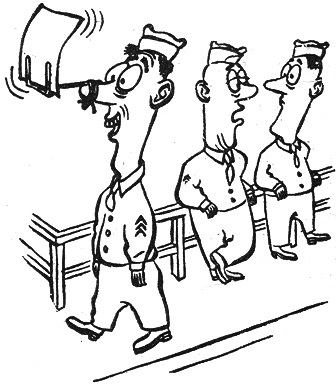 "It's just his discharge papers."
"It's just his discharge papers."
|
New WD Plan For Officers Studied Here
NEW DELHI - A War Department plan to give full consideration to the individual wishes of officers as concerns their release from duty is reflected in a circular issued this week by Theater headquarters.
The plan gives weight to the wishes of the officers involved, but also provides for the utilization of officers who wish to continue on extended active duty.
All officers will be asked to sign statements before Jan. 31 committing themselves to one of five categories outlined by the War Department:
1. I elect to continue on extended active duty for unlimited length of time.
2. I elect to continue on extended active duty until 30 June 1947.
3. I elect to continue on extended active duty until 31 December 1946.
4. I elect to continue on extended active duty until a date to be agreed upon at least 60 days from date this statement is signed and not later than 30 November 1946.
5. I desire to be relieved from active duty at the earliest opportunity.
Legislation is pending in Congress to authorize the integration of approximately 10,000 wartime officers into the Regular Army. Officers to be taken into the Regular Army will be selected on a standardized competitive basis. General fitness, intelligence and physical standards will be considered.
The officer must hold a temporary rank equal to or higher than the rank to be offered, which extends from second lieutenant through major.
The circular calls attention to the fact that movement of dependents and household goods in the United States is now at government expense. Travel of dependents at government expense also is now authorized to the Bahamas, stations of the Caribbean Defense Command, Brazil, Bermuda, Newfoundland, Alaska and Hawaii.
In order to provide equitable tours of overseas and Zone of Interior service, the War Department has under consideration a policy which will prescribe a maximum overseas tour of two and one-half years.
Effective immediately, all outstanding statements whereby an officer has volunteered to continue on extended active duty are revoked and the new categories of statements are substituted.
The Roundup is a weekly newspaper of the United States Forces, published by and for the men in Burma and India, from news and pictures supplied by staff members, soldier correspondents, Army News Service and United Press. The Roundup is published Thursday of each week and is printed by The Statesman in New Delhi and Calcutta, India. Editorial matter should be sent directly to T/Sgt. John C. Devlin, Hq., U.S.F., I.B.T., APO 885, New York, N.Y., and should arrive not later than Saturday in order to be included in that week's issue. Pictures must arrive by Friday and must be negatives or enlargements. Stories should contain full name and organization of sender. Complaints about circulation should be sent directly to Capt. Drexel Nixon, Base Section APO 465, New York, N.Y. Units on the mailing list should make notification of any major change in personnel strength or any change of APO.

|
JANUARY 3, 1946
Adapted from the original issue of India-Burma Theater Roundup
Similar, better quality image of Rita Hayworth, used in this re-creation.
Copyright © 2018 Carl Warren Weidenburner
TOP OF PAGE PRINT THIS PAGE ABOUT THIS PAGE SEND COMMENTS
PREVIOUS ISSUE CLOSE THIS WINDOW NEXT ISSUE
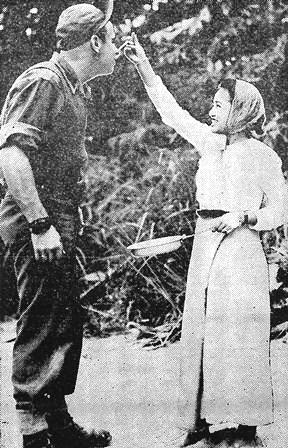 A pretty Burmese nurse of the Seagrave hospital unit at Namkham feeds this hungry member of America's forces in Burma.
A pretty Burmese nurse of the Seagrave hospital unit at Namkham feeds this hungry member of America's forces in Burma.
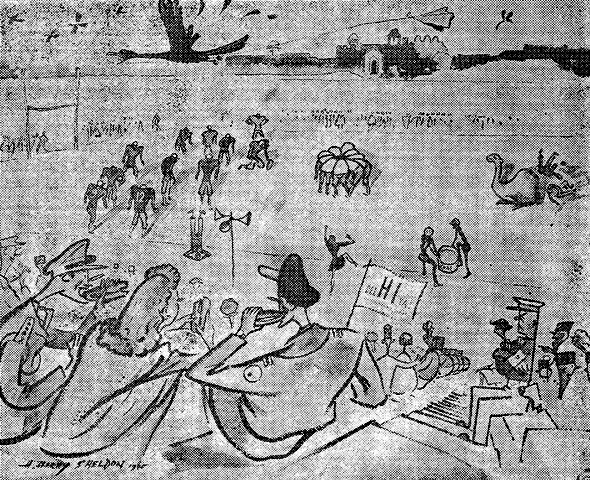 This drawing of the North-South football game at New Delhi on Christmas Day was done by British Capt. H. H. Sheldon.
You may recall his work in Phoenix magazine. His official capacity is as war artist for the Indian Army.
The South won, 21-0, but you can't prove it by Capt. Sheldon.
This drawing of the North-South football game at New Delhi on Christmas Day was done by British Capt. H. H. Sheldon.
You may recall his work in Phoenix magazine. His official capacity is as war artist for the Indian Army.
The South won, 21-0, but you can't prove it by Capt. Sheldon.